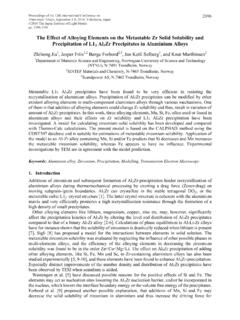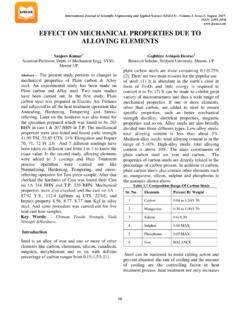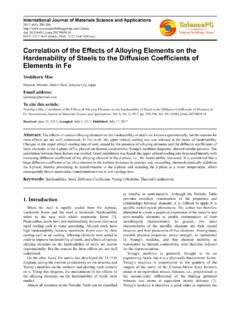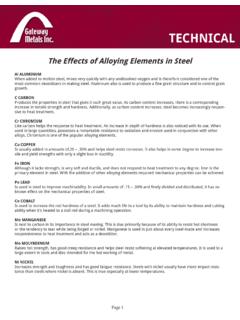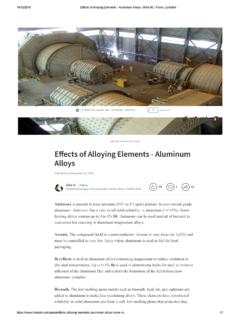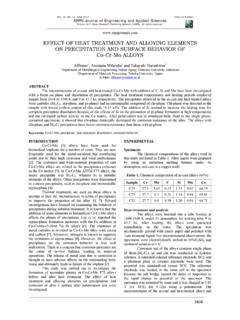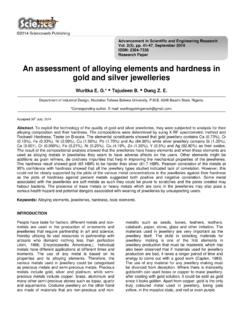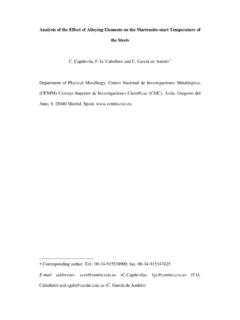Transcription of Effects of Alloying Additions and Cooling Rate on the ...
1 Proceedings of the 12th International ConferenceonAluminium Alloys, September5- 9, 2010, Yokohama, Japan 2010 The Japan Institute of Light MetalsEffects of Alloying Additions and Cooling Rate on the Microstructures and Mechanical Properties of the Cast Al-Mg-Si Alloys Jung-Moo Lee1, Kyung-Hyun Kim1, Hwa-Jung Kim1,2, Yong-Sik Ahn21 Structural Materials Division, Korea Institute of Materials Science, Changwon, South Korea2 Pukyung National University, Pusan, South KoreaCast aluminum alloys are widely applied for the transportation industry. Alloys with silicon and magnesium as the main Alloying elements are the most important of the aluminum casting alloys because of their high fluidity. However, Al-Si-Mg alloys have exhibited medium strength level at room and, especially, at elevated temperature.
2 Recently, new casting alloys with high magnesiumand silicon have been developed. The Al-Mg-Si alloys with the eutectic structure of -Al + Mg2 Keywords:casting; Al-Mg-Si; Copper; Nickel; elevated temperatureSi are of practical interest due to their excellent strength and good fluiditycomparable to Al-Si-Mg alloys. In the present work, the Al-Mg-Si alloys with various amounts of copper and/or nickel have been fabricated using the step mold in order to impose the different Cooling rate. The Effects of Alloying elements and Cooling rate on the microstructures and mechanical properties of Al-Mg-Si alloy have been with silicon as the main Alloying element are the most important of the aluminum casting alloys mainly because of the high fluidity imparted by the presence of relatively large volume of the Al-Si age-hardenable Al-Si alloys usually doped with Mg, Cu, Zn, Fe, Ni, Mn and Ti exhibit good casting properties, excellent corrosion resistance and strength.
3 Thus, they are widely used in the automotive industry to improve fuel efficiencies and to reduce vehicle , componentsoperating at elevated temperatures such as piston of high performance engine require mechanical properties which can hardly be reached for commercial Al-Sicasting alloy systems [1, 2]. In addition, alternative commercial castingalloy system such as Al-Cu alloys exhibit higher strength at elevated temperatures but are limited in application due to poor casting attentionhas been paid on to develop new casting alloy systems whichimprove elevated temperature properties[1, 3]. Recently, new casting alloys with high magnesiumand silicon have been developed. The Al-Mg-Si alloys with the eutectic structure of -Al + Mg2In the present work, the Al-Mg-Si alloys with various amounts of copper and/or nickel have been fabricated in order to improve the mechanical properties at elevated temperature above 200Si are of practical interest due to their excellent strength and good fluiditycomparable to Al-Si-Mg alloys[3].
4 Copper is mainly added to increase the strength at room temperature by heat treatment and at elevated temperature through formation of compounds with iron, manganese and nickel [4]. Addition of nickel improves the elevated temperature properties of aluminum alloys [4]. Effects of Alloying elements and Cooling rate on the microstructures and mechanical properties of Al-Mg-Si alloy pure Al, Si, , and pure Mg were used as starting materials. was the base alloy, and addition of Cu and Ni varied to 0~ and 0~ to the base alloy, respectively. About 8 kg of the alloys were melted at 800oC in a graphite crucible in an electric resistance furnace. The melt was degassed with Ar gas using GBF(gas 1708 Proceedings of the 12th International Conference on Aluminium Alloys, September 5-9, 2010, Yokohama, Japan 2010 The Japan Institute of Light Metals p p.)
5 1708 -1713 Proceedings of the 12th International ConferenceonAluminium Alloys, September5- 9, 2010, Yokohama, Japan 2010 The Japan Institute of Light MetalsEffects of Alloying Additions and Cooling Rate on the Microstructures and Mechanical Properties of the Cast Al-Mg-Si Alloys Jung-Moo Lee1, Kyung-Hyun Kim1, Hwa-Jung Kim1,2, Yong-Sik Ahn21 Structural Materials Division, Korea Institute of Materials Science, Changwon, South Korea2 Pukyung National University, Pusan, South KoreaCast aluminum alloys are widely applied for the transportation industry. Alloys with silicon and magnesium as the main Alloying elements are the most important of the aluminum casting alloys because of their high fluidity. However, Al-Si-Mg alloys have exhibited medium strength level at room and, especially, at elevated temperature.
6 Recently, new casting alloys with high magnesiumand silicon have been developed. The Al-Mg-Si alloys with the eutectic structure of -Al + Mg2 Keywords:casting; Al-Mg-Si; Copper; Nickel; elevated temperatureSi are of practical interest due to their excellent strength and good fluiditycomparable to Al-Si-Mg alloys. In the present work, the Al-Mg-Si alloys with various amounts of copper and/or nickel have been fabricated using the step mold in order to impose the different Cooling rate. The Effects of Alloying elements and Cooling rate on the microstructures and mechanical properties of Al-Mg-Si alloy have been with silicon as the main Alloying element are the most important of the aluminum casting alloys mainly because of the high fluidity imparted by the presence of relatively large volume of the Al-Si age-hardenable Al-Si alloys usually doped with Mg, Cu, Zn, Fe, Ni, Mn and Ti exhibit good casting properties, excellent corrosion resistance and strength.
7 Thus, they are widely used in the automotive industry to improve fuel efficiencies and to reduce vehicle , componentsoperating at elevated temperatures such as piston of high performance engine require mechanical properties which can hardly be reached for commercial Al-Sicasting alloy systems [1, 2]. In addition, alternative commercial castingalloy system such as Al-Cu alloys exhibit higher strength at elevated temperatures but are limited in application due to poor casting attentionhas been paid on to develop new casting alloy systems whichimprove elevated temperature properties[1, 3]. Recently, new casting alloys with high magnesiumand silicon have been developed. The Al-Mg-Si alloys with the eutectic structure of -Al + Mg2In the present work, the Al-Mg-Si alloys with various amounts of copper and/or nickel have been fabricated in order to improve the mechanical properties at elevated temperature above 200Si are of practical interest due to their excellent strength and good fluiditycomparable to Al-Si-Mg alloys[3].
8 Copper is mainly added to increase the strength at room temperature by heat treatment and at elevated temperature through formation of compounds with iron, manganese and nickel [4]. Addition of nickel improves the elevated temperature properties of aluminum alloys [4]. Effects of Alloying elements and Cooling rate on the microstructures and mechanical properties of Al-Mg-Si alloy pure Al, Si, , and pure Mg were used as starting materials. was the base alloy, and addition of Cu and Ni varied to 0~ and 0~ to the base alloy, respectively. About 8 kg of the alloys were melted at 800oC in a graphite crucible in an electric resistance furnace. The melt was degassed with Ar gas using GBF(gas bubbling filtration) for 15 minutes and poured into the metallic mold.
9 Two types of metallic mold were used to impose the Cooling rate. Fig. 1 shows the shape ofthe molds. The step mold is made by steel and the wall thickness of the mold varies from 25 to 43mm. The measured Cooling rates of the step mold , , and 20K/s, respectively. Water- Cooling mold was made by metallographic techniques were employed to examine the microstructures of the specimens. The microstructures were characterized using an optical microscope, a scanning electron microscope (JSM5800)equipped with energy dispersive X-ray spectrometer (EDS).Measurement of lattice parameter was carried out using a Rigaku X-ray diffractometer (XRD) with Cu-K radiation at 40kV and mechanical properties of the specimenswere evaluated by means of compression tests (strain rate of 7x10-3s-1) performed on polished specimens of 8mm in diameter and 12mm in 1 Shapes of (a) the step-mold and (b) water- Cooling and discussionFigure2 shows the as-cast microstructures of with the addition of copper and nickel.
10 In the base Al-Mg-Si alloy, the microstructure is composed of -Al and eutectic Mg2Si. With the addition of Cu and/or Ni new second phases were formed in the microsturctures. The phases were confirmed as Al3Ni, CuMgAl and CuNiAlby the observation of SEM/EDS. In addition, with increasing Cu and/or Ni contents the formation of primary Mg2 Figure3 shows the as-cast microstructures of with Cooling rate. With increasing Cooling rate the microstructures become fine and especiallythe size of AlSi is clearly observed. 3Ni. However, nosignificant change occurred for the volume fraction of Al3In the heat-treatablealloys such as Al-Cu, Al-Cu-Mg, Al-Mg-Si and Al-Mg-Si-Cu, the dissolved elements in aluminum exhibit a decreasing solubility with decreasing temperature.
